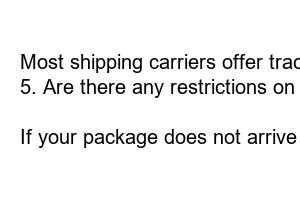해외배송시 영어주소
English Address for Overseas Delivery: A Comprehensive Guide to Hassle-Free Shipping
In today’s globalized world, it has become increasingly common for individuals and businesses to send and receive parcels across borders. When it comes to international shipping, a critical factor to consider is the accuracy and clarity of the recipient’s address. By following proper addressing guidelines, you can ensure the smooth delivery of your package and avoid unnecessary delays or even returns. In this blog post, we will provide you with a comprehensive guide to correctly addressing your package for overseas delivery.
1. Why is a proper address crucial for overseas delivery?
Incorrectly addressed packages often face multiple hurdles during shipping, including misrouting, delays, or even being returned to the sender. To ensure that your package reaches its intended destination successfully, it is vital to provide a complete and accurate address, including the recipient’s name, street address, city, postal code, and country.
2. The importance of using the recipient’s full name
When addressing your package, it is crucial to include the recipient’s full name. This helps the shipping carrier identify the exact individual who should receive the package, reducing the likelihood of confusion or potential delivery errors.
3. Including the street address and landmarks
Apart from including the recipient’s name, providing the precise street address is equally important. Make sure to include any necessary additional information, such as building numbers or names, along with any local landmarks that aid in identifying the location. This extra detail helps the carrier accurately locate the delivery address, especially in areas with complex or non-standardized addressing systems.
4. City, postal code, and country: Essential components of the address
Including the correct city, postal code, and country is crucial for successful delivery. These details assist in narrowing down the destination and ensure that your package reaches the intended location without any unnecessary detours. Remember to use the internationally recognized format for postal codes and clearly state the name of the country in English to avoid any confusion.
5. The role of clear and recognizable handwriting
While most shipping labels are now generated electronically, there are instances where manual address writing becomes necessary. When handwriting the address, always use clear, legible, and preferably block letters. Illegible or messy handwriting can lead to misinterpretations and potential delivery issues.
6. Ensuring customs compliance
When sending goods internationally, it is crucial to adhere to customs regulations. Before shipping, familiarize yourself with the specific requirements of the destination country to prevent any customs-related complications. Including necessary customs documentation, such as the commercial invoice, further facilitates the clearance process.
In summary, correctly addressing your package is paramount for successful overseas delivery. By including the recipient’s full name, accurate street address, city, postal code, and country, you can significantly reduce delays and avoid potential returns. Additionally, clear handwriting and compliance with customs regulations play essential roles in ensuring smooth transportation. Now that you are equipped with these addressing guidelines, you can confidently arrange your next overseas delivery without any worries.
FAQs:
1. Can I use local language when addressing my package for overseas delivery?
It is best to use English when addressing your package for international delivery to minimize potential language barriers and ensure accurate understanding by shipping carriers.
2. What should I do if I am unsure about the recipient’s address?
In case of uncertainty, it is always advisable to double-check the recipient’s address with them directly before shipping to avoid any potential errors or delivery issues.
3. Is it necessary to include my return address on the package?
While not mandatory, including a return address provides an added layer of security. In case the package cannot be delivered, it allows the shipping carrier to return it to you instead of being lost or abandoned.
4. How can I track my package during overseas delivery?
Most shipping carriers offer tracking services that allow you to monitor the progress of your package. Keep the tracking number provided by the carrier and use it to access real-time updates on your shipment.
5. Are there any restrictions on what I can send internationally?
Yes, different countries have varying restrictions on the types of items that can be shipped. It is crucial to familiarize yourself with both the destination country’s customs regulations and any prohibited items listed by the shipping carrier.
6. What should I do if my package does not arrive?
If your package does not arrive within the expected timeframe, it is best to contact the shipping carrier first. They will be able to provide more information and assist you in locating your package.

